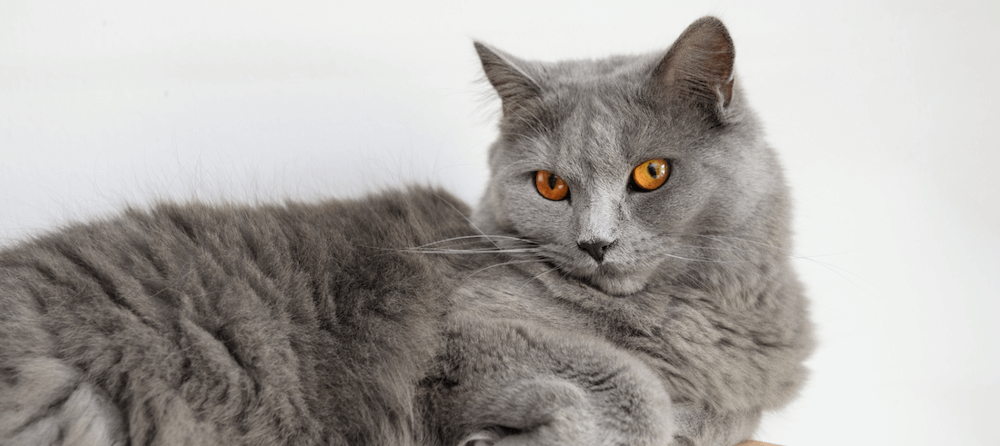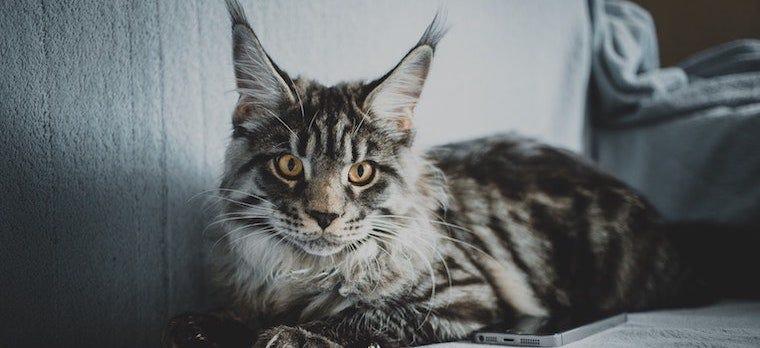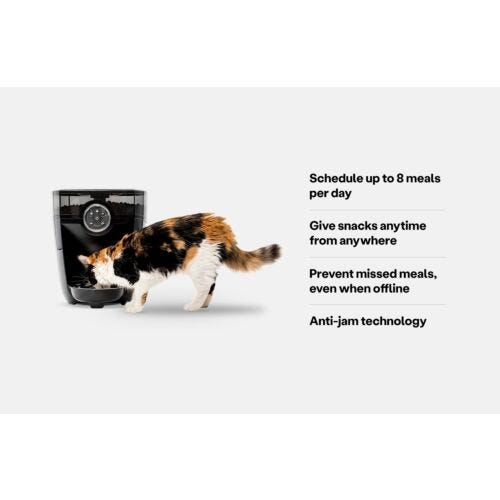With an adorable round face attached to a sturdy yet agile body, the Chartreux cat is a French breed that is easy to fall in love with. They have notable solid blue-grey coloration that helps them to stand out from other cat breeds, especially when you feel how dense their fur is.
Chartreux (pronounced shär-TRUE) cats are also known to have a very pleasant demeanor and make for a great family pet. They are tolerant and loving with a charmingly playful spirit. They are independent cats and might not spend every second of their day following you around.
Of course, that doesn’t mean they aren’t paying close attention and keeping tabs on you. They tend to bond deeply with their humans and will be sure to keep an eye on you when you’re around, mainly because they love you!
Keep reading to learn more about the Chartreux breed and just how lovable they can be!
| Chartreux cat | ...at a glance |
|---|---|
| Personality | Calm, quiet, docile |
| Life expectancy | 11-15 years |
| Weight | 7-16 lbs |
| Coat & colors | Medium-short, wooly; blue-grey |
| Energy level | Medium |
| Affection level | High |
| Friendliness | High |
| Shedding level | Medium |
| Required grooming | Medium |
Overview of the Chartreux cat
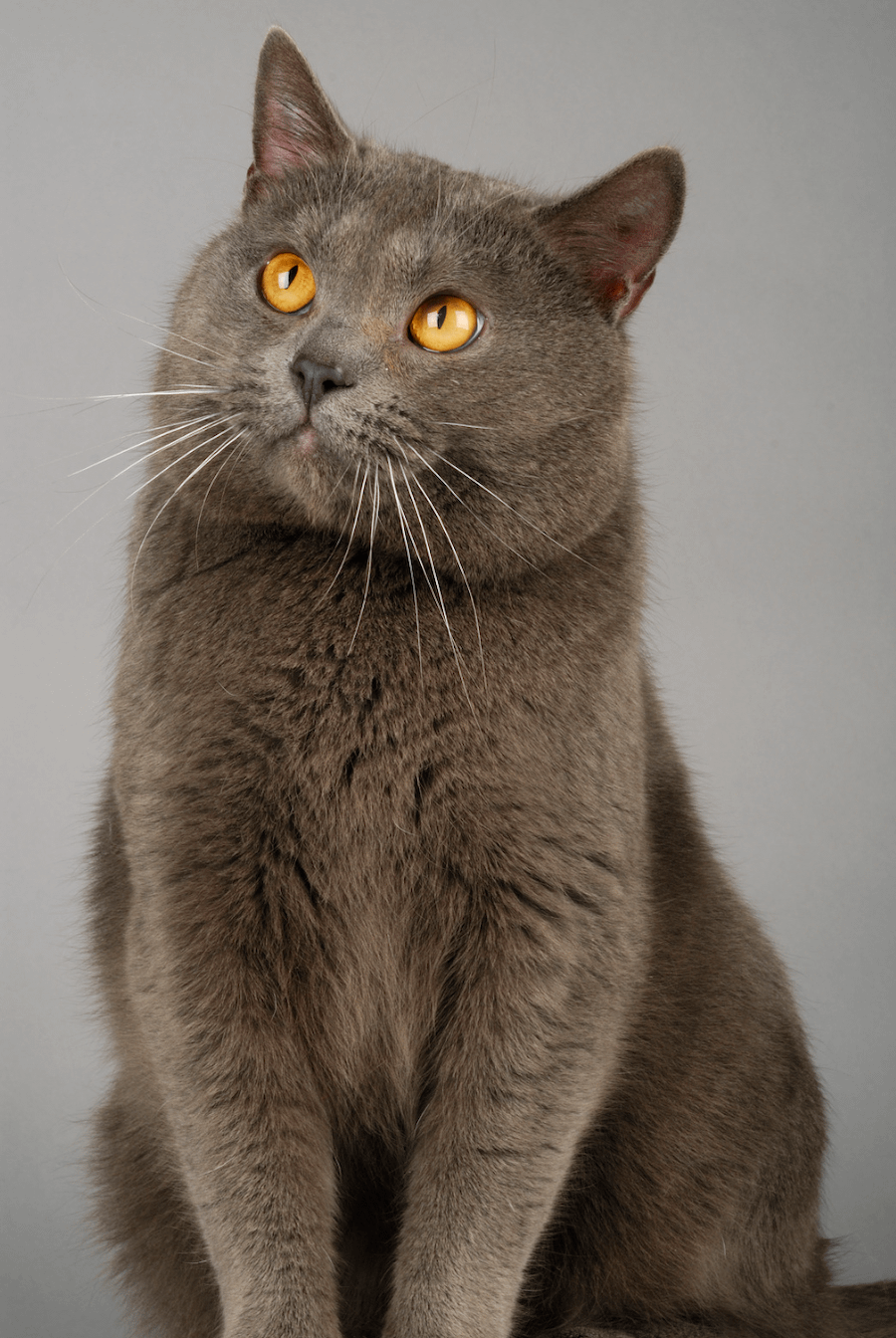
This French feline is well-loved in their home country, and, naturally, that love has spread across the ocean to North America. These sturdy cats can range in size, but many are on the larger side. They are strong and nimble, and might surprise you with their quickness and flexibility.
Weight
Despite their short legs, male Chartreux cats are somewhat large compared to average cats. Males can weigh up to 16 pounds, while their female Chartreux cats typically weigh significantly less at 9 pounds or fewer.
These cats are not known to be particularly active, so it’s important to keep a close eye on their weight. Ensuring they get proper nutrition and exercise can help them maintain a healthy weight.
Length
Chartreux cats reach up to 24 inches in length, from their short noses to the ends of their tails. This gives them a very long appearance, which contradicts their short legs and just how low their bodies are to the ground.
Due to this funky makeup of short, skinny legs and a long, round body, they resemble “potatoes on toothpicks,” as many Chartreux breeders lovingly say.
Coat
A Chartreux's blue-grey coat is one of their most defining features and consistent across the breed. The coat is medium-short in length, thick, and dense. It is fairly wooly in texture and can be very comforting to stroke.
Chartreux kittens can have some tabby coloring with a silky texture. But as they grow, those markings fade, and their coats become more resilient. A Chartreux’s coat is water-repellent and can withstand harsh weather conditions. However, they tend to heavily shed their undercoat throughout the year, especially during the spring and summer. This is true for many animals with double coats, including short-haired cats.
Life expectancy
Chartreux cats can live 11 to 15 years when they are properly cared for. With regular check-ups with their veterinarian, a nutritious diet, and the right amount of exercise, your Chartreux may live a long and happy life.
The best way to ensure that your cat spends as many days with you as possible is to pay attention to their health.
History of the Chartreux
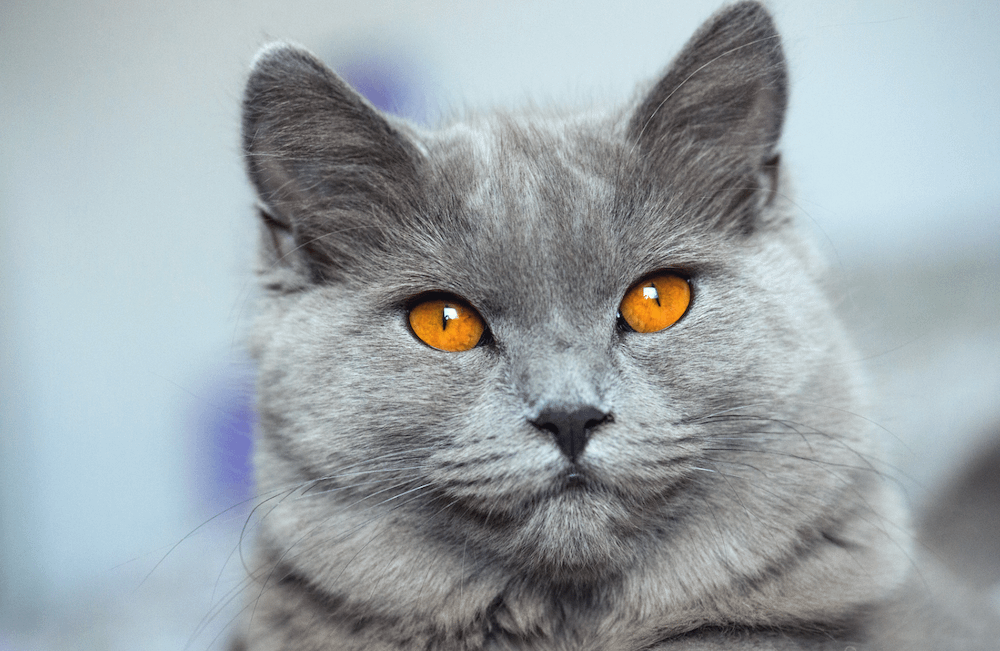
The 16th century
The Chartreux cat is believed to come from a southeastern area of France. Here they were the pest control for the Carthusian order of monks in the 16th century after being relocated from the mountains in Syria.
The story goes that the Carthusian monks bred cats that could be quiet as a mouse while performing mouser duties to avoid disturbing the monks during their ceremonies or practices. While charming, this origin story hasn’t been proven, and experts are wary.
The 18th century
This breed has been around for centuries, but it's hard to exactly distinguish when they surfaced. However, there are depictions of the Chartreux in paintings done by Jean-Baptiste Perronneau in the 18th century, indicating that these loyal, adaptable cats were highly respected and well-taken care of.
The 1920s
In the 1920s, we begin to see a clearer, more recorded explanation of how the Chartreux we know and love today came about.
Sisters Christine and Suzanne Leger discovered a small island off the coast of France that had a colony of blue-grey cats living on it. The Leger sisters took some of these cats, domesticated them, and bred them to have wooly, blue-grey coats, a staple they were trying to embed into the breed.
World War II to the present
During World War II, the Chartreux breed risked becoming extinct. Luckily, European cat breeders and enthusiasts jumped in to save the day. By breeding the Chartreux with Russian Blue cats and British Shorthairs, the unofficial cat of France was saved.
They were fully accepted into the Cat Fancier’s Association (CFA) in the 1980s, earning their champion status, but have been a French national treasure for decades. They aren’t very prevalent in the United States.
In fact, this cat only arrived stateside recently. It wasn’t until 1970 when Helen Garmon of La Jolla, California, brought the first Chartreux to the USA.
Chartreux cat characteristics
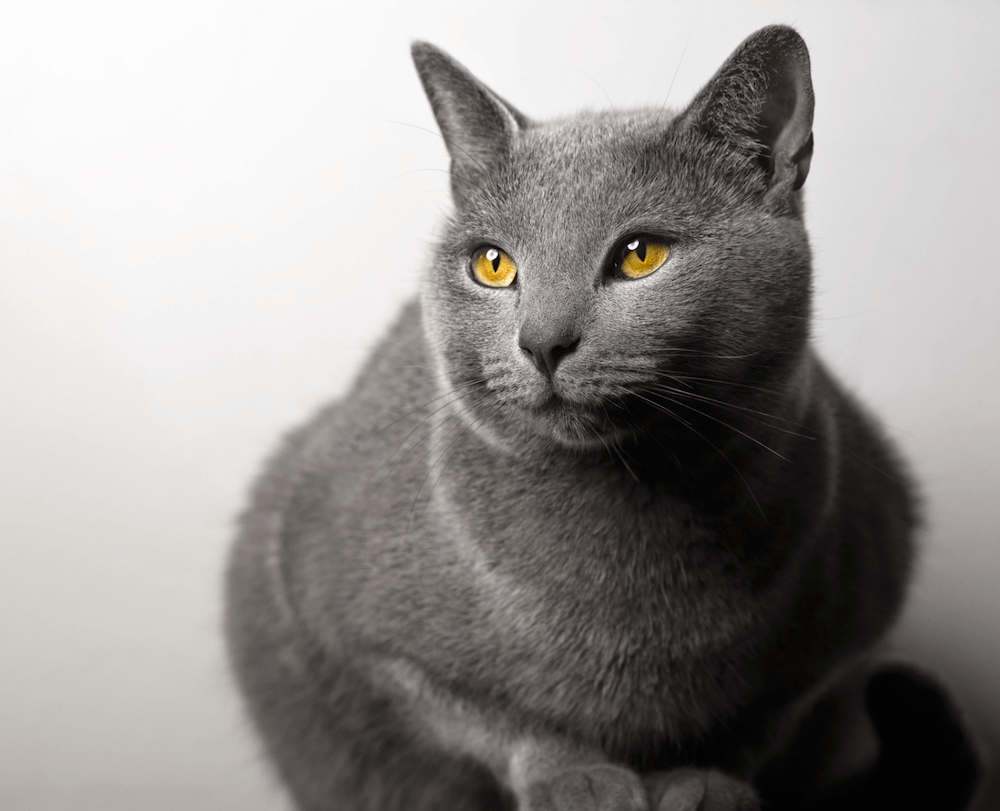
A Chartreux’s body may seem disproportionate at first glance. They are often longer than they are tall, with small legs, round bodies, and large, piercing eyes. Chartreux eye colors range from copper to gold, but a deep, brilliant orange is preferred!
Despite their proportions, they have powerful bodies and fast reflexes, making them adept hunters. They aren’t known to be very active, though, so don’t expect to see them showing off their skills too frequently.
With their blue-grey coats, they are sometimes mistaken for Russian Blues and British Shorthairs. However, they are smaller and woolier than the British Shorthair and aren’t as silver in coloring as the Russian Blue.
Personality and behavior
One of the best features of the Chartreux cat is their personality. They are typically quiet and laid-back cats with lower activity levels than other breeds. While they have a playful side to them, they aren’t going to be bouncing off walls.
This cat might become obsessed with one member of their family (likely the one who regularly feeds them), but they will form a bond with every person in the house. They love cat toys that they can hunt and enjoy when their humans get involved.
Chartreux cats are intelligent; keeping them occupied with mental stimulation is usually enough to tire them out. They like games and puzzles but enjoy a pleasant spot for a cat nap. Many people that have a Chartreux talk about how they seem to have a sense of humor and know how to make a good joke.
However, what they don’t really do is meow. This cat is far more likely to chirp or trill.
Caring for a Chartreux cat
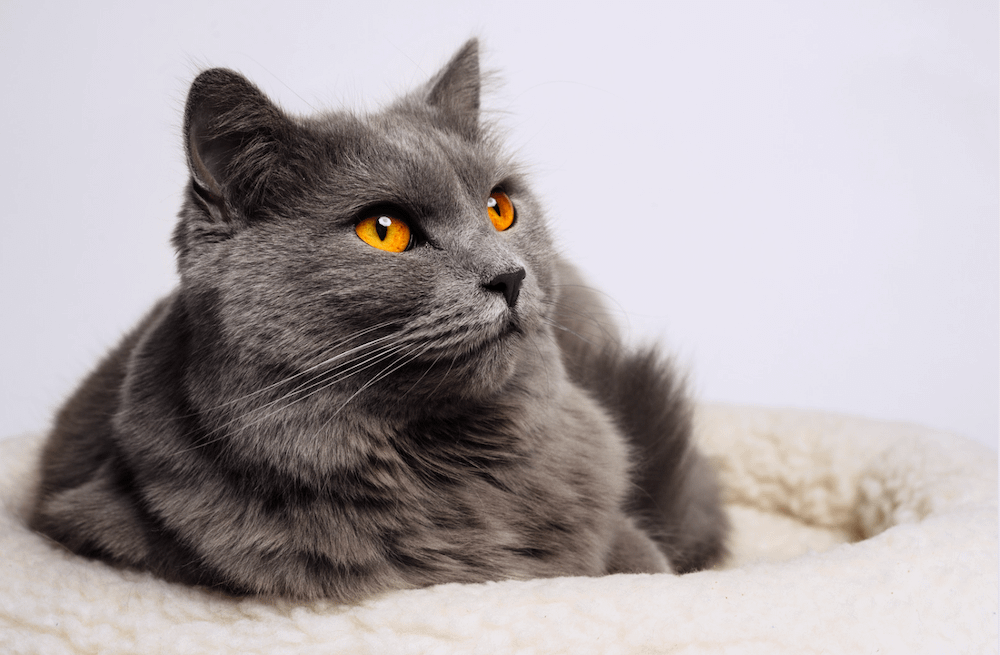
Chartreux cats are known to be low maintenance when it comes to keeping them busy and active. They aren’t vocal and don’t make demands unless absolutely necessary. They likely won’t crawl onto your lap or get in your face to ask for attention.
They are more likely to graciously accept attention when it’s given and show that they care through smaller acts of love. Rubbing against your legs briefly as you come into the room and greeting you with a quiet chirp after a long day at work is more up their alley.
You’ll want to treat your Chartreux with dignity, as they look up to their humans with respect. Keeping your cat’s bathroom area clean with a self-cleaning litter box can ensure that they never have to go potty in a dirty space. Maintaining their grooming and care in general ensures they are as comfortable as possible.
Grooming
Weekly brushing will likely do the trick of keeping your Chartreux’s coat in good shape. During the warmer months, you might need to brush daily to help as they shed some of their wooly fur. On their own, the Chartreux typically does a suitable job of keeping themselves cared for and well-groomed.
As long as you brush their coat often enough to keep it from matting, this time spent with your cat will be great for bonding. If you can get your Chartreux to enjoy grooming, it becomes a lot easier to accomplish!
Health-related issues
Chartreux cats are overall healthy, but can be prone to some medical issues. This includes polycystic kidney disease, which is when cysts form on their kidneys. Luxating patella can also impact this breed; this is a health problem that occurs when the kneecaps slip from their intended location.
Additionally, your Chartreux might be more prone to struvite stones, which is when small stones form in your cat’s bladder as a result of dehydration or an excessive alkaline diet. When this happens, the stones can block the urethra and cause kidney failure.
Welcoming a Chartreux to your home
You will begin to know your cat better the longer they spend time with you. A friendship will soon form with your Chartreux, and you’ll be able to tell if there is anything you should be worried about when it comes to their health. You will start to pick up on their quirks as they pick up on yours.
Preparing to take home a Chartreux cat shouldn’t be overwhelming as long as you have plenty of toys, napping spots, and nutritious food at your disposal. It may take some time for your Chartreux to open up to you, but when they do, you will find you’ve made a friend for life.
Sources:
